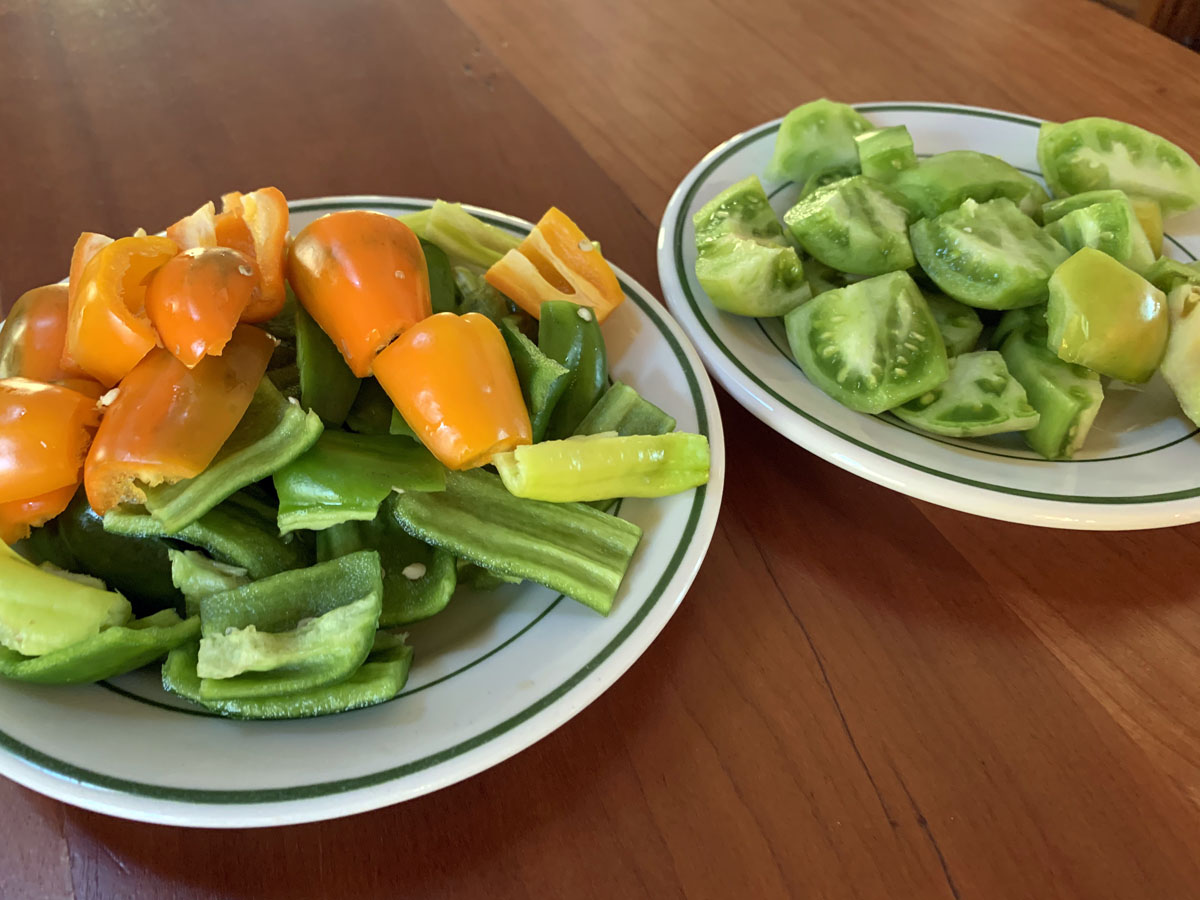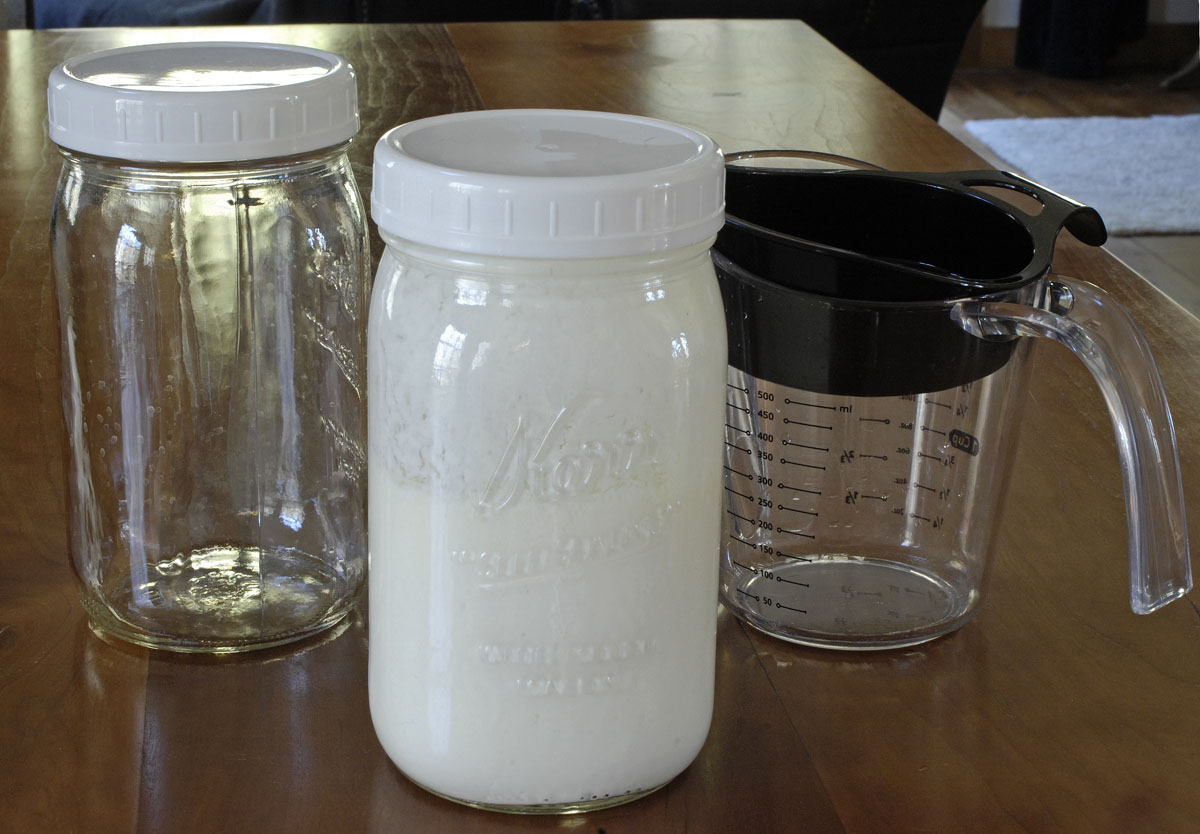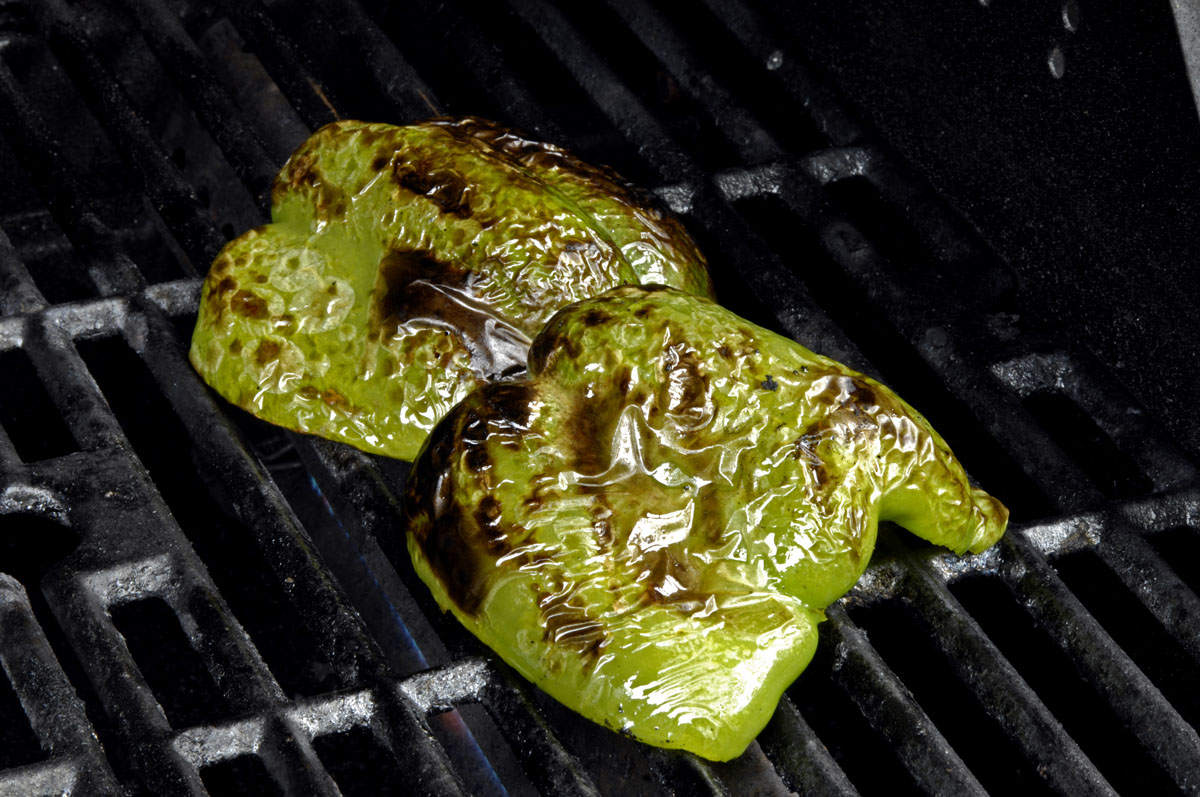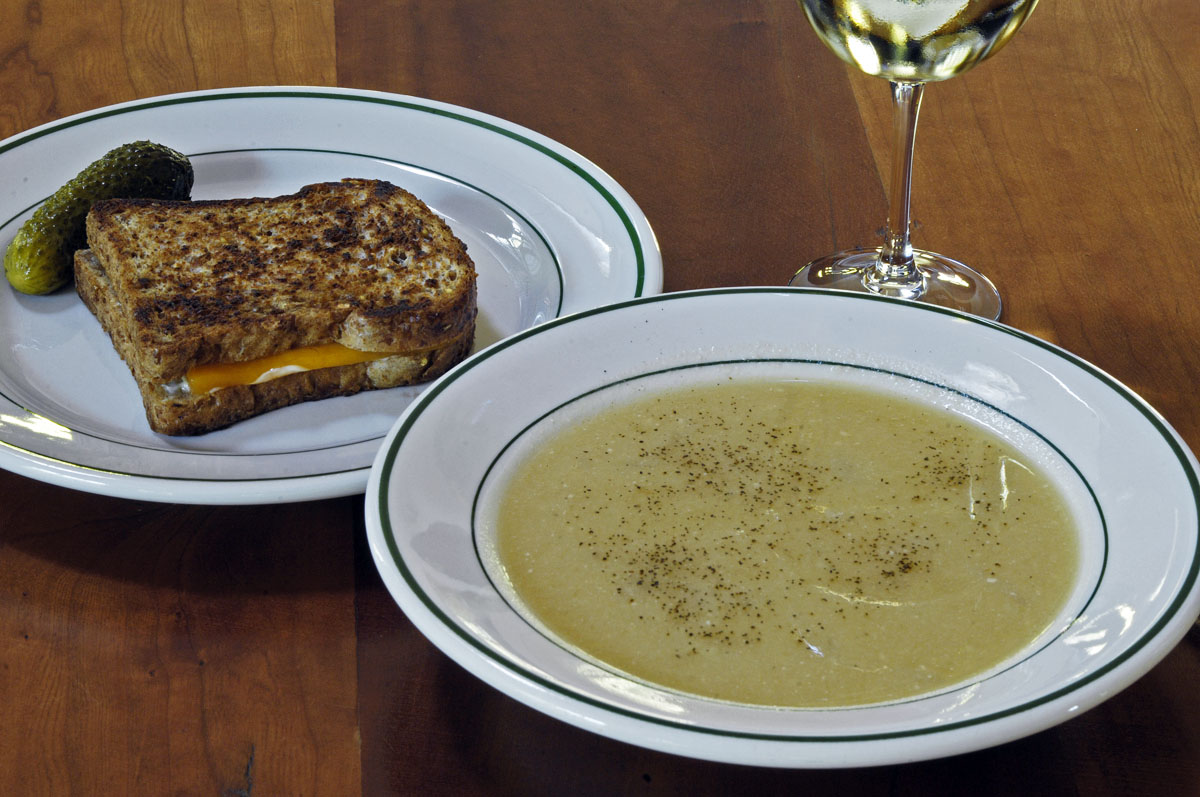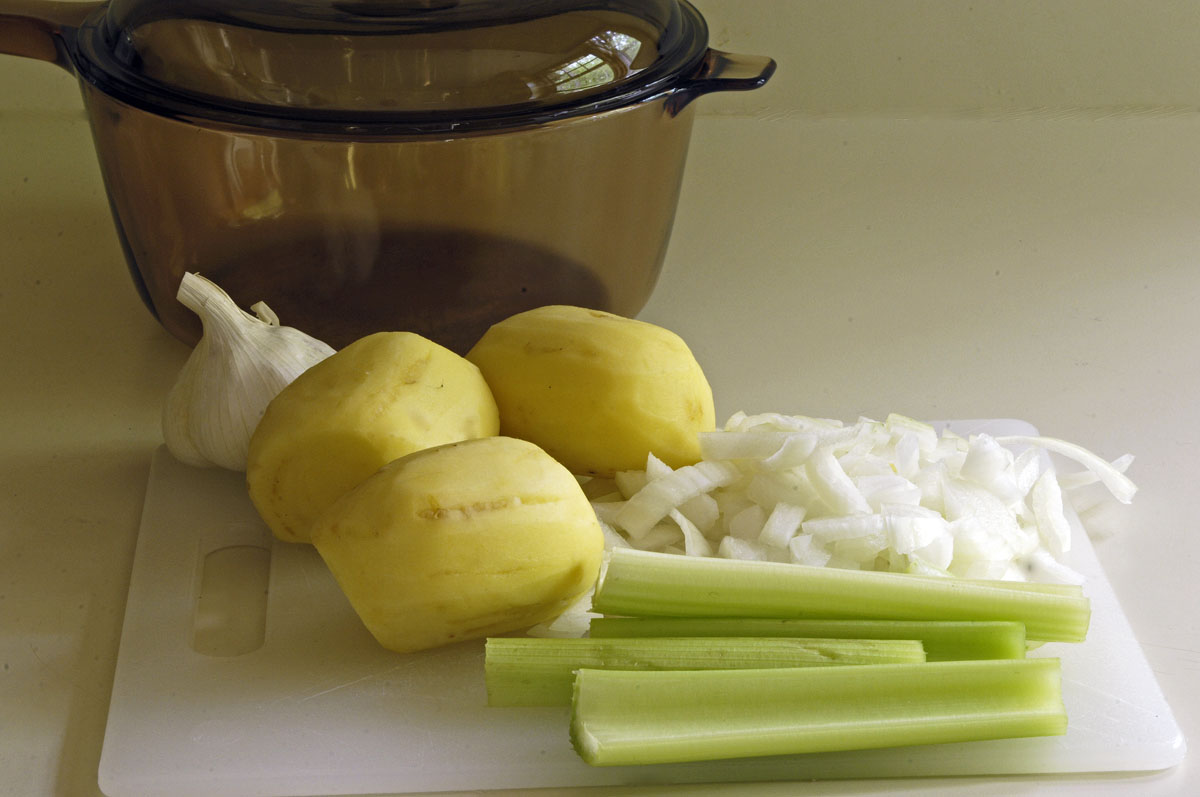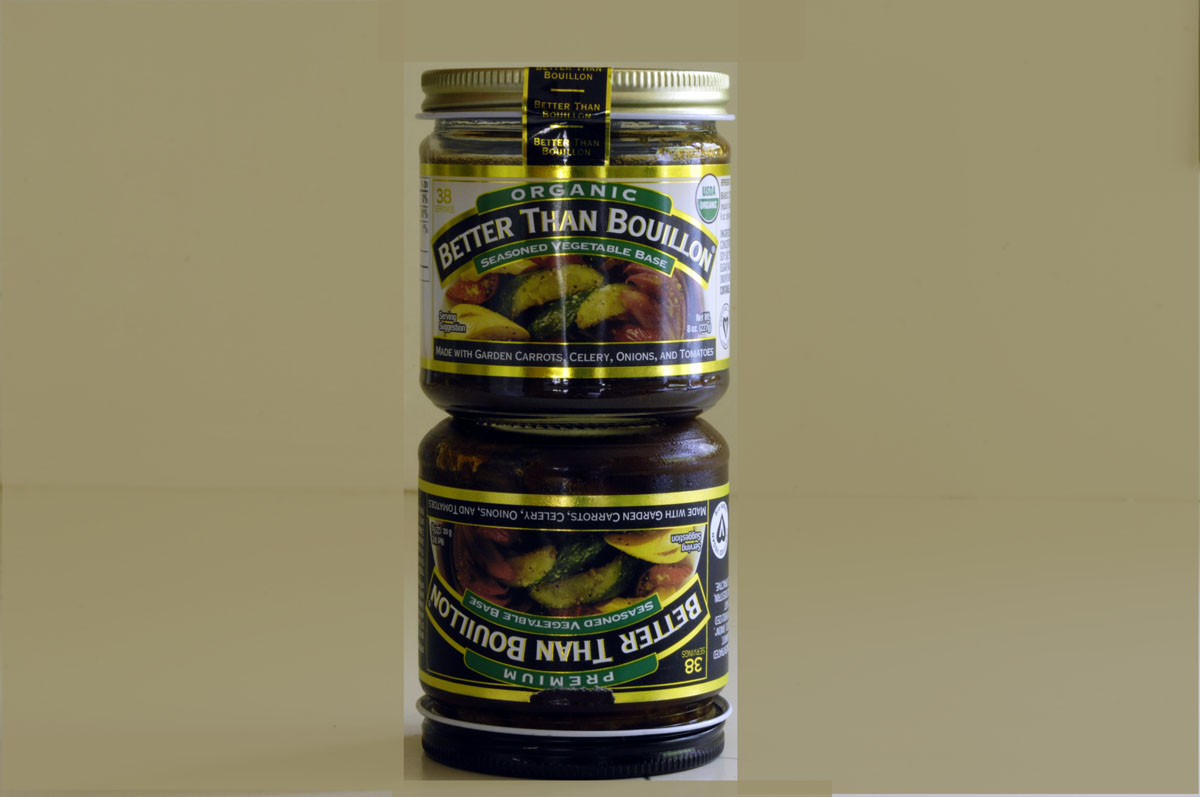Mrs. Squirrel looks down at me from her lofty perch high up the back of the house. The four little ones have not yet left the nest in my attic, as far as I know. As soon as the little ones are up and away, I’ll nail in enough metal fabric to make sure that her next children are raised in the woods.
Fried barley?
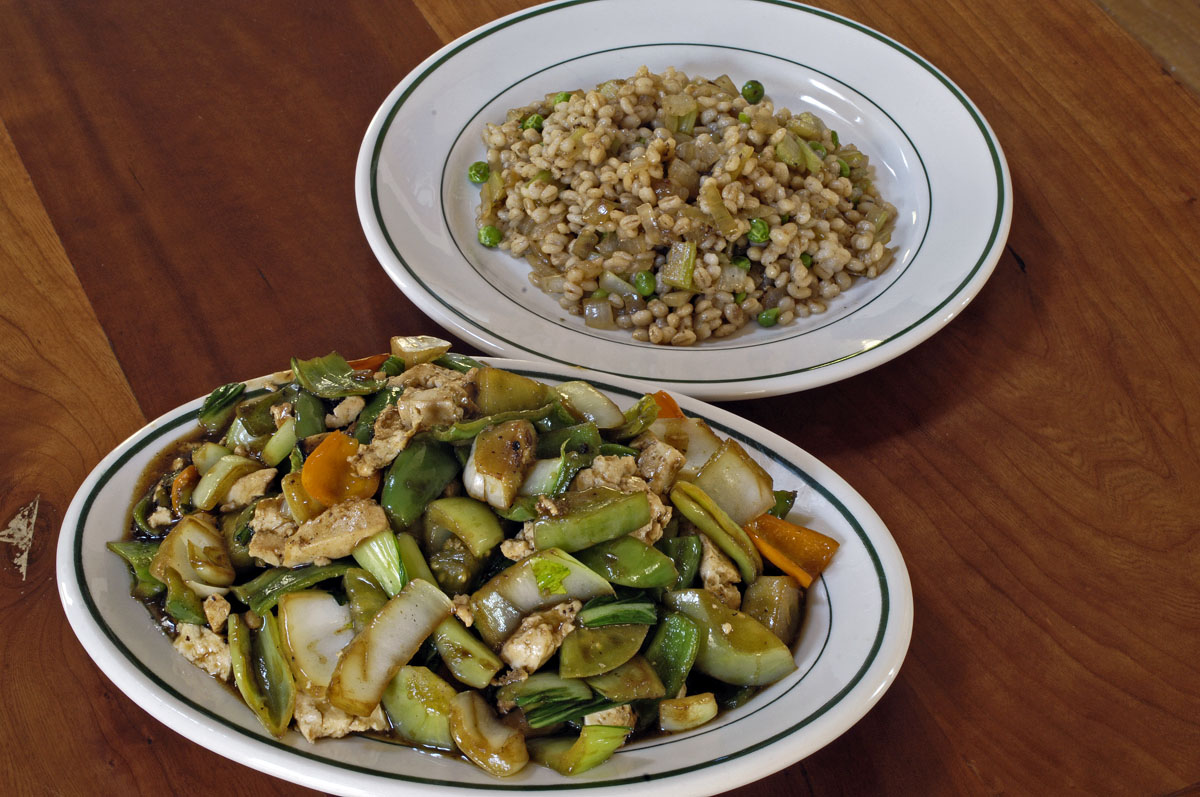
Good-bye garden stir fry with fried barley
For the longest time, I had been planning to see if fried barley can compete with fried rice. Yes it can.
The chewy texture of barley makes great fried rice. The grains are sturdy and are not at risk of turning to mush when thrown around in the wok. The grains love a thin coating of sauce, but they don’t drink it up the way rice does. You’ll eat less, because barley takes longer to chew.
The stir fry above contains lots of green peppers and green tomatoes given to me by a neighbor. They had picked the last remaining parts of their garden (which was a lot) before the first freeze. Green tomatoes are brilliant in a stir fry or curry.
They’ll move right in if you let them
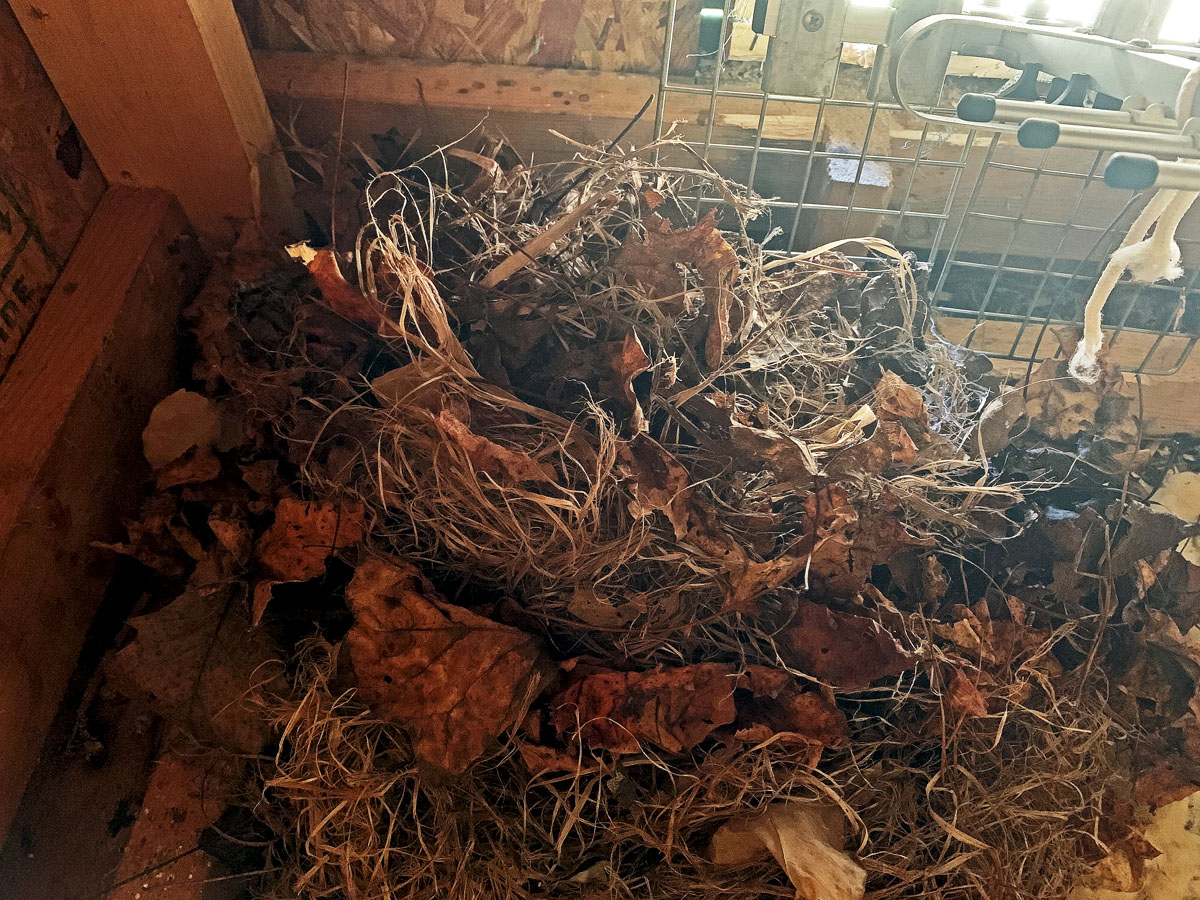
Mrs. Squirrel’s nest in my attic
For a year or two, I have been chasing a pesky squirrel off the deck. My argument with it (she turned out to be a she) was that she had plenty of space in the woods, so go home. She also loved climbing on the house. She would often sit on the deck railing and scratch, and I blame her for the case of fleas that Lily — a house cat — acquired last fall. Some months ago she started gnawing on a ventilator grill about twenty feet up the back of the house. I chased her away and threw potatoes at her more than once.
Then I heard a scratching noise in the attic. She had gotten in. I tried to plug the hole as a temporary fix. She gnawed around it. Two weeks ago, I went up to investigate the scratching and found four baby squirrels. Mommy left when she heard me coming, but the babies were sound asleep. They were several weeks old, I’m sure, because they had plenty of fur and were the size of two-week-old kittens. I was defeated. What choice do I have but to let them live there until the babies are grown?
I checked on the babies today after seeing Mrs. Squirrel in the front yard eating leaves of some sort. She had brought in litter and had built a very snug squirrel’s nest, because the weather has turned cold. I heard rustling inside the nest but didn’t disturb the babies.
Mrs. Squirrel has become shameless, though I have not tried to tame her. I scold her, and she just looks at me and barks. She’s also curious about the grill on the deck. Either she’s trying to get inside it, or she smells food. She gets close enough to me that I can see her wet little teats.
Living up against the woods as I do, it would be easy to be too lenient with all the creatures needing safe homes and a handout. It’s a forest, really, and there are coyotes and an occasional bear. Mrs. Squirrel wouldn’t mind the deer, but there are plenty of owls and hawks. If it’s safety that she’s looking for here, then she’s less afraid of me than what’s in the woods. I’m flattered. But if the doors here stayed open for too long, I’d soon have opossums, raccoons, and skunks, all expecting supper, and a warm fire, and bedtime stories. The voles, at least, stay in the basement. A few weeks ago I discovered that Mrs. Raccoon was bringing her three children to eat the leftovers that I put out in the backyard for the possum. She’d be among the first to arrive.
I can imagine worse neighbors, though.
Kefir
Kefir-lovers swear that kefir has even more probiotic virtue than yogurt. I have read that kefir culture persists in our digestive systems but that yogurt culture is transient. I have no idea if that is true. But personally I find that I like kefir better. And kefir is easier to make than yogurt.
Yogurt needs to incubate at a bit higher than room temperature. Hence we use yogurt makers to keep the culture warm. Kefir, on the other hand, works its magic at room temperature. You don’t need anything to make kefir other than a culture to start with, some glass jars, a coarse strainer, and some good milk.
Yogurt is easy to find. Kefir is not as common. Store-bought kefir, though you can buy it plain, is usually heavily sweetened and fruit flavored, increasing the calories by at least 50 percent. If you’re new to kefir, it’s something you drink rather than eat with a spoon. Kefir thickens as it cultures. It looks — and tastes — a lot like buttermilk. But if the information one Googles up can be believed, kefir is a more complex colony of bacteria than buttermilk.
I love the taste of plain kefir. It “sparkles” in the mouth like champagne. The freshly fermented flavor gets up your nose. When you drink fresh kefir, you know it’s alive.
To get started with kefir, you need a starter culture, which is called “kefir grains.” Kefir grains look to me like cottage cheese. You can order them from Amazon. It will take a week or so to re-invigorate kefir grains. They survive being mailed, but they don’t like it. After your kefir grains are healthy and happy and you start your kefir routine, you strain the grains from the finished kefir and put the grains into a new batch of fresh milk. I plan to experiment with vegan kefirs made from coconut milk (which I understand works fine) and almond milk, though I believe kefir is healthiest and happiest in cow’s milk or goat’s milk. You can put your kefir culture on hold — for a while — by putting it into the refrigerator. But like all cultures such as sourdough bread cultures, kefir needs to be periodically fed.
Those of you who were health nuts back in the 1970s will remember the nutritionist Adele Davis. In those days, the emphasis was on vitamins and minerals and protein. As a hippy who also had a copy of Jethro Kloss’ Back to Eden, I realized even then that the mystery of good health was more complicated than just vitamins, minerals, and protein. Since then, we’ve learned a great deal more about the importance of our internal flora. I don’t use a lot of milk. Too much milk causes me to gain weight. But I think that a good policy would be, when one drink’s milk, to drink only a cultured milk such as kefir.
Here’s a hat tip to one of this blog’s readers (she knows who she is) who counseled me on getting started with kefir.
A road trip to the real Mayberry
Here is a video from today’s road trip into the Blue Ridge Mountains. American readers will be aware of the “Mayberry” angle from the classic American television show with Andy Griffith. Those of you in Europe may not be aware of the cultural complications, which relate to the fact that Andy Griffith the actor was a liberal but that most of those who idolize Griffith, and the television show, are make-America-great-again deplorables.
But never mind all that. It was a nice road trip with some autumnal Blue Ridge Mountain scenery, a wonderful local historian who has had a book of science fiction open every time I’ve been in her store, and scenes from the kitchen of the chef who made my lunch.
Catherine the Great

Helen Mirren in HBO’s Catherine the Great
The sets and costumes and colors are lavish. Helen Mirren is, as always, a remarkable actress. But one episode of Catherine the Great was all I can take.
Just as every story with a classical structure needs a villain, so every story needs at least one decent human being. In this story, there aren’t any. There’s no one to like, including Catherine the Great. It’s all debauchery and treachery and cruelty, all the time.
It has never mattered to me whether a story is “true to life.” I prefer the opposite, actually, because to me stories are about escape and imagination. Life itself is true to life, and that’s enough. HBO’s mini-series about Catherine the Great may be true to life, and true to history, for all I know. If I cared enough, I’d read a history. But, as a story, there was no one in it worth caring about — except, maybe, the Russian people, who, at least in episode 1, never appear.
Recently I wrote a book review here on the history of tyrants. Of the three types of tyrants that Waller Newell describes, Catherine the Great was a “reforming tyrant.” She did Russia proud. Is there something about the Russian people that they can be led only by tyrants? Or is it that tyrants are all the Russian people have ever known? I don’t know enough Russian history to try to answer the question. But I think I’m glad that I’m not Russian.
A fresh take on pimento cheese

Pimento cheese made from fresh roasted green peppers, served with my homemade borscht
I was reflecting today on the history of pimento cheese, which, since my earliest childhood, has been a Southern American favorite. It seemed oddly Mediterranean, because nobody around here has ever grown pimiento peppers, nor does anybody can peppers, as far as I know. Luckily, the story of the history of pimento cheese has already been written, and I came across this article from Southern Living: You Will Not Believe the History of Pimento Cheese.
It turns out that my speculation was right. According to the article, it was back in the 1870s that Spain started sending canned red peppers to the United States. America supplied the cheese. Pimento cheese was born.
When I was a young’un, there was often a little glass jar of pimento peppers in my mother’s cabinets for making pimento cheese. If you make it at home (I’m thinking that nobody ever does anymore), the ingredients would be cream cheese, some cheddar, and some mayonnaise. All groceries stores here have it, though, in plastic tubs. If you read the ingredients, you’ll faint, because store-bought pimento cheese is usually made from cheap, artificial ingredients such as “cheese food.”
Last time I was at Trader Joe’s, I bought too much Wisconsin cheddar, and I’ve been hard pressed to use it all. Pimento cheese seemed like a good idea. Cream cheese is not something I normally buy. But Greek yogurt was a good substitute. And I never run out of mayonnaise.
You could use any kind of pepper, red or green, even mildly hot ones, if you like the idea. I roasted a sweet green pepper on the grill. Let it cool, then peel it and chop it. I marinated my green pepper for an hour or so in some of the marinade from a jar of marinated artichoke hearts. Stir the chopped peppers into the grated cheddar, plus the cream cheese (or Greek yogurt) and a dollop of mayonnaise.
Update: A vintage can of tinned pimentos that was for sale on eBay.
What authoritarians see
This photo, which I assume is an official White House photo, is historic. We’re going to see it for the rest of our lives, in documentaries about Donald Trump’s impeachment and how we almost lost the American republic to a gang of tawdry, slow-witted, money-grubbing little boys who grew up mean and twisted. Nancy Pelosi’s role as the heroine in this drama is now a given.
As you probably know from yesterday’s news, the photo first became public when Trump tweeted it, with the caption “Nervous Nancy’s unhinged meltdown!”
Pelosi immediately made it her Twitter header photo, and the photo went viral.
Molly Roberts has a good column in this morning’s Washington Post, The Nancy Pelosi photo is a Rorschach test for an America cleaved into two. Molly Roberts is exactly right. What authoritarians like Trump and Trump supporters see in the photo is entirely different from what we liberals see.
Shortly after Pelosi and Senator Chuck Schumer walked out of the meeting, Pelosi held a press conference in which she talked about what happened in the meeting. (There’s a video clip from the press conference with Molly Roberts’ column.) Pelosi said, “At that moment, I was probably saying, ‘All roads lead to Putin.'”
To authoritarians, Trump is the Big Man. He is the bully-in-chief, their little God figure who belittles and pushes around all the people that right-wing authoritarians don’t like. He makes little dime-a-dozen authoritarians everywhere believe that he’s making them great again. To authoritarians, the very idea that a woman, any woman, would loom over Donald Trump at the White House cabinet table and tell the Big Man to his face that he is a traitor to the United States of America is highly offensive. If a woman like Nancy Pelosi is not supportive of Donald Trump, then she is supposed to be afraid of him. That’s the way things are supposed to work in the authoritarian utopia that we’re all expected to live in once all those feckless little authoritarians have made America great again.
On the other hand, we liberals don’t give a damn about authority and power. When authority is wrong and wicked, we stand up and say stick it up your nose. When power is corrupt and tells lies, we speak truth to it. Finger-wagging is optional, but standing up to deliver truth to power is essential. It’s the finger-wagging, though, that makes this photo so historic. Trump is being told just how little he really is. Notice how the old men to Trump’s right are hanging their heads, under the bust of Ben Franklin. The photo is perfect. It’s astonishing that an authoritarian mind such as Trump’s can think that the photo makes him look good and Nancy Pelosi look bad.
It wouldn’t hurt to keep in mind that Nancy Pelosi isn’t just anybody. She’s a very rich woman from San Francisco, and right now she is not only the most powerful woman in the country, she’s also the most powerful person in the country (and she knows it). She is third in line to the presidency as the law closes in on both Donald Trump and Mike Pence. Part of what the photo reveals is that the tables have turned. Trump’s weakness and bluster are exposed. Trump is already defeated, though the process for getting him out of the White House and off to prison will take a while longer.
Once Trump is gone, several million of his adoring followers are still going to be with us. It remains to be seen whether right-wing propaganda will try to find a new Trump and keep Trumpsters enraged or whether it will try to win them over to an old and boring standby such as Mitt Romney and a saner kind of politics. If the Republican Party should decide that yet more rage and division best serve its purposes, then we’re going to have millions of Trumpsters in our faces, their gloating turned to fury, some of them wanting civil war. Nancy Pelosi is setting an example. The law and the Constitution are on our side. We do not report to Vladimir Putin. We don’t have to take that sitting down.
But is it good writing?
The New Republic’s excellent obituary for Gene Wolfe points out that, as Notre Dame cathedral was burning back in April, word was flying around the Internet that Gene Wolfe had died. Lots of readers saw the strangeness of the coincidence, because, near the end of The Shadow of the Torturer, the narrator Severian sees what appears to be a vision:
“Hanging over the city like a flying mountain in a dream was an enormous building — a building with towers and buttresses and an arched roof. I tried to speak, to deny the miracle even as I saw it; but before I could frame a syllable, the building had vanished like a bubble in a fountain, leaving only a cascade of sparks.”
The book ends before the reader is told what Severian actually saw (it was not a vision, you’ll learn later in the series). Though Wolfe did not proselytize, he was a devout Catholic. “I do not write Catholic books intentionally,” Wolfe had once said. The New Republic’s obituary called Wolfe the Proust of science fiction. That gets it about right, I think.
I had not read Wolfe for many years, but a few days ago I shelled out $11.99 for a Kindle edition of The Shadow of the Torturer. That’s a lot of money for a Kindle book. For some reason, it’s almost impossible to find new science fiction that I find worth reading. So I thought why not catch up on some 1980s classics that I hadn’t read.
In the world of science fiction and fantasy, a holy war has gone on for decades about whether Wolfe was, or was not, a good writer. One Goodreads reviewer wrote, “I tried. Fuck it.” But Ursula K. Le Guin saw Wolfe’s novels as masterpieces.
I’m late to the Gene Wolfe holy war, but since the war has flared up again now that Wolfe has died, hand me my gun.
I probably was born wearing an editor’s visor with a book in my hand. I have rather strong opinions about whether writing is good or not. But of course, tastes differ. And there are many kinds of writing. No one can declare what good writing is; we can only read and argue.
The mind of a good editor, like the mind of a good writer and the mind of a good reader, is complex. But I would say that there are certain minimum standards that a piece of writing must meet before we can even ask the question whether it is good or not. I have two modes of editing. The first mode I call “bit level mode.” The second level I call “high altitude mode.”
Imagine that an editor is sitting in front of a computer with a piece of writing on the screen. The writer who wrote the piece of writing is sitting behind the editor. Often editors must edit without the writer present, but the collaborative mode of editing, with writer and editor side by side, works best. The writer sees what the editor is doing, and, if the editor is a good one, the writer sees why.
It’s in bit level mode that basic matters of grammar, syntax, and usage get worked out. I’ve often said that writers and editors must work very hard so that readers don’t have to. A piece of writing should be as friction free and transparent as possible, so that the reader can glide through it without ever having to stop and work out an ambiguity or a vagueness. For example, the word “live” can be a verb, or it can be an adjective. Upon hitting the word “live,” it must be clear to the reader from what preceded the word “live” whether it’s a verb (“to live well”) or an adjective (“live clams”). If that’s not clear, then the reader is obliged to read on to be able to determine how the word “live” was intended. In effect, the sentence must be read twice to be parsed correctly by the reader. That’s friction. A million little things like this get fixed during bit level editing.
High altitude editing is far more interesting. For this the writer and editor don’t sit at the computer. They go to lunch and drink.
If the piece of writing in question is a newspaper article about a county commissioners’ meeting (or even an important email or letter) then no high altitude lunch is needed at all. But if the piece of writing in question is a novel, or a memoir, then the high altitude elements are what matter most. (For an example of a beautifully written memoir from my own Acorn Abbey Books, see Denial.)
In my experience as a reader and editor, some people can write, and some people cannot. Plenty of people write who cannot write. I fling their books all the time after ten or twenty pages.
But how does one decide whether a writer can write or not? Again, there is no single standard. We can only argue. But if you asked me how I determine whether someone can write or not, it would be this: Writers either have, or do not have, an ear for their mother tongue. Editors often say that a certain writer has a “tin ear.” An ear for language is developed not only by reading, but also by listening — and by listening not only to language, but also to music (and poetry). I can speak here only for my own mother tongue, English. English has its own natural rhythms and musicality. Writing is like composing.
I’m going to come around to Gene Wolfe soon, I promise.
Anyway, if it’s philosophy we’re reading, we expect it to be dense and complex and wordy, because it has to be. But if a piece of fiction is dense and complex and wordy, then writers had better know what they’re doing.
As a prime example of a tin-eared writer of dense fiction, I’d suggest Hilary Mantel, whose writing in her novel about Thomas Cromwell I found not just bad but offensively, insultingly bad. This tends to happen when a writer is trying to cultivate a reputation for “style.” To me, a “style” just means quirky and irritating. It’s the sort of thing that creative writing teachers often encourage, and it produces the kind of dreadful novels that the New Yorker likes to review. I’ve also written here, some years ago, about the fascist, machine-gun rhythms of Ayn Rand’s prose.
Gene Wolfe’s writing is certainly complex. The reader does have to work at it a bit, though the prose easily passes all the tests that prose must pass during bit level editing. But what makes Wolfe’s writing work is that Wolfe has an ear for English. That’s what makes all the difference. He’s a composer. He’s also a philosopher.
And with that I’ll leave you with a sample, so that you can decide for yourself:
It was on that walk through the streets of still slumbering Nessus that my grief, which was to obsess me so often, first gripped me with all its force. When I had been imprisoned in our oubliette, the enormity of what I had done, and the enormity of the redress I felt sure I would make soon under Master Gurloes’s hands, had dulled it. The day before, when I had swung down the Water Way, the joy of freedom and the poignancy of exile had driven it away. Now it seemed to me that there was no fact in all the world beyond the fact of Thecla’s death. Each patch of darkness among the shadows reminded me of her hair; every glint of white recalled her skin. I could hardly restrain myself from rushing back to the Citadel to see if she might not still be sitting in her cell, reading by the light of the silver lamp.
We found a cafe whose tables were set along the margin of the street. It was still sufficiently early that there was very little traffic. A dead man (he had, I think, been suffocated with a lambrequin, there being those who practice that art) lay at the corner. Dr. Talos went through his pockets, but came back with empty hands.
“Now then,” he said. “We must think. We must contrive a plan.”
Soup season, at last
And all at once, summer collapsed into fall.” — Oscar Wilde
One of the things I learned in Scotland this summer is that my culture of origin — Southern American — is not really a soup culture, though maybe it would be more accurate to say that the climate of the American South is not really a soup climate. Not until cool weather arrives do the soup pots come out (if anybody other than me still uses soup pots).
In Scotland, especially in the Highlands and islands, soup is welcome on the table year round. Even in August, a friend who grew up in rural Ireland made some amazingly imaginative vegetarian soups. In these parts, you’d get some funny looks (and, in some households, shot) if you put hot soup on the table in August.
This year, August just wouldn’t go way. Summer persisted until early October with highs in the 90s, and then at last the weather changed. I turned off the cooling system and flung open the windows to let the nip in. While the cat sat in the window and pressed her nose against the screen to eye the birds, I was eyeing a soup pot and checking the contents of the fridge. For the first fall soup, I decided on a simple potato soup with onions, celery, and a whiff of garlic.
The challenge with vegetarian soups is the stock. I almost never buy ready-made soup stocks. Lord knows what’s in them. And the vegetarian versions almost always have some kind of weird, strong flavor that jumps into the foreground. The stock is a soup’s background. It should be savory but subtle. Another problem with store-bought soup stocks is that they’re mostly heavy liquid that weighs down the grocery bags. They’re not worth lugging home. My usual solution is the family of bouillons made by Better Than Bouillon. They’re light in the grocery bag, very concentrated, and they keep forever in the refrigerator. And let’s not forget that water makes a big difference. The water here comes from my own deep well (305 feet, with the lower 270 feet of it solid rock), and the drinking and cooking water goes through a charcoal filter.
There is no milk or cream in this soup. I thickened it by whizzing most of the potatoes in the blender when the soup was almost done. I also added some tahini. (Mix liquid slowly into the tahini to make a smooth sauce before adding it to the soup). Nut butters make great thickeners for soups. Peanut butter goes well in any soup that contains tomatoes. Tahini can stand in for milk or cream. This would have been a vegan soup except that it contained a little butter. I cooked it very slowly for three and a half hours, barely bubbling, covered.
Speaking of soup pots, I’m very happy with my new scheme of using only old-fashioned cookware. For sauces, sautéeing, and reducing, I’m using heavy tin-lined copper pots, vintage, bought on eBay. For frying and baking, I’m using cast iron, including a cast iron wok. For soups and anything that wants to boil, I’m using vintage Corning Visions cookware bought on eBay. Using glass cookware is a bit eccentric, but I like it because glass is so inert and does not affect the flavor of things — a particular problem with things such as soups and stews that cook long and slow.


